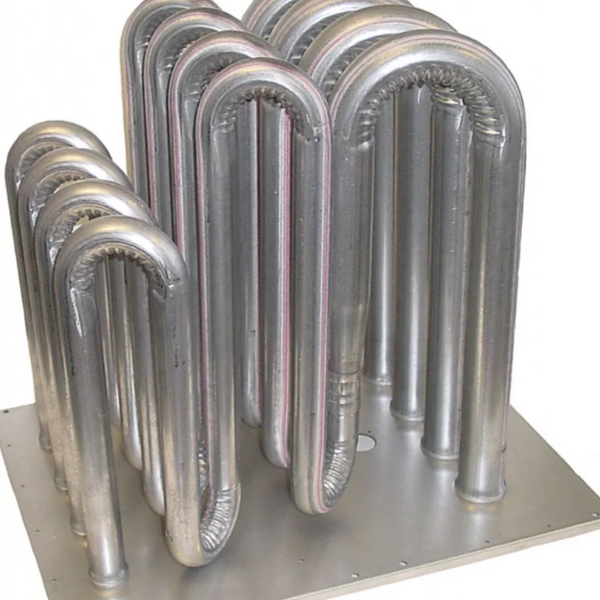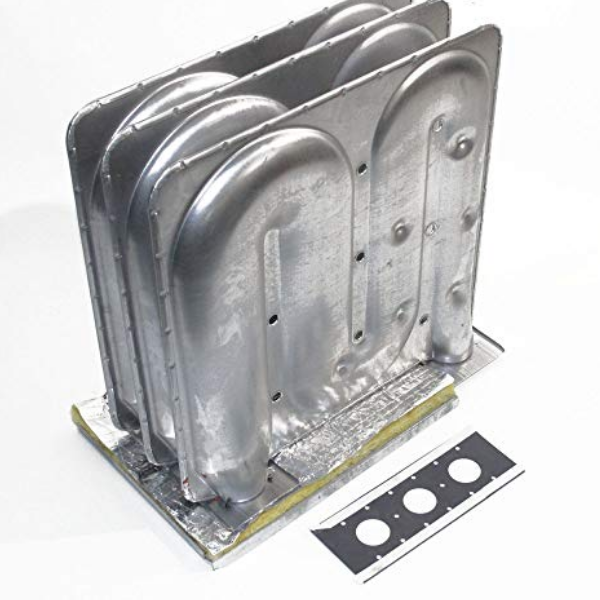Plate furnace heat exchanger with rubber gasket
The structure of the gasket-plate furnace heat exchanger consists of a series of thin metals made of Stainless Steel, Titanium, Hastelloy, etc. Which are sealed together with synthetic rubber gaskets and sturdy frames, forming compartments for hot and cold fluids to run

Flow compartments/slots are specially designed to produce maximum turbulence for both fluids, increasing heat transfer efficiency. The two fluids usually enter and exit at the top and bottom ports of the heat exchanger respectively or vice versa according to the inverse principle.
Advantages of furnace heat exchanger
The advantage of a rubber gasket heat exchanger is that the panels are easy to remove for cleaning and customized to add or remove panels to suit the needs of heat transfer. Advantages of rubber gasket plate heat exchanger:
- Firstly, high heat transfer efficiency (large heat transfer area).
- Secondly, energy-saving.
- Easily removable for cleaning and maintenance.
- Also, simple spare parts.
- Structure, compact installation.
- Moreover, competitive investment and installation cost.
- Finally, allows power adjustment.
Sealed plate heat exchanger
The advantage of a hermetically sealed plate furnace heat exchanger is that it can withstand high temperatures up to 2000C and pressures up to 30 bar. These are
- High heat transfer efficiency
- Withstands very high working pressure and working temperature.
- Energy-saving.
- Structure, compact installation.
- Competitive investment and installation cost.
Semi-hermetic heat exchanger
Basically, similar to a rubber gasket plate heat exchanger, but the refrigerant is gas. Detail: Semi-hermetic furnace heat exchanger is composed of pairs of thin metal plates that are sealed together by a laser.
These pairs of metal plates are called cassette pairs, the cassette pairs are interlaced with each other by sealing gaskets. Here, the gaseous medium (NH3) will flow on the surface of the cassette pair, and the remaining fluid will flow in the gap between the cassette.
Advantages of semi-welded heat exchangers
- High heat transfer efficiency (large heat transfer area).
- Energy-saving.
- Easily removable for cleaning and maintenance.
- Simple spare parts.
- Also structure, compact installation.
- Competitive investment and installation cost.
- Easy to increase heat capacity
Tubular plate furnace heat exchanger
A device with a beam-tube-like furnace heat exchanger, the structure consists of thin metal sheets Tig/Mig welded together to form a block and nested in a cylindrical tube. Between the slots of the metal plate will contain gas (NH3) fluid remains will flow through a cylindrical shell.
Hopefully, through this article, you can give an overview of the plate furnace heat exchanger, so that you can convert and choose the best option to bring more value to the plant. This type of pipe comes in two main styles: fully sealed and a removable cover for easy cleaning.
Advantages of tubular heat exchangers:
- Easy to disassemble and clean.
- High furnace heat exchange
- Asymptotic to the maximum temperature.
- Take care of many functions on the same device.
- Avoid environmental influences.
- Moreover, less scale.
- Low cost.
What is thermal energy?
Heat is a form of energy stored in matter through the chaotic thermal motion of the particles that make up matter. The molecules that makeup matter are in constant chaotic motion, and thus they have kinetic energy.
The heat energy of an object is the sum of the kinetic energy of motion of the center of mass of the molecule. The kinetic energy of oscillations of the atoms that make up the molecule around the common center of mass and rotational k.E of the molecule around the center of mass.

Thermal energy and temperature relationship
Thermal energy has a close relationship with temperature. Accordingly, the higher the temperature of the object, the greater the thermal energy of the object because the molecules that make up the object move faster.
Heat is easy to exchange through processes of radiation, conduction, and convection. As the kinetic energy of particles increases the temperature also rises. So the temperature of the furnace heat exchanger can is increased.
What is heat?
Heat is understood as the amount of heat energy that an object gains or loses in the process of heat transfer. The amount of heat absorbed by an object to heat up depends on three factors:
- Firstly when the mass increases the heat absorbed also increases.
- Temperature rise: temperature and heat absorbed are in a direct relation
- Substances that makeup objects.
The calculation formula for heat:
The heat in furnace heat exchanger is calculated using the following formula:
Q = mc∆t
Inside:
- Qis the amount of heat absorbed or released by the object. The unit is Jun (J).
- mis the mass of the object, measured in kilograms.
- cis the specific heat of the substance, measured in J/kg.K
Specific heat of a substance
The specific heat of furnace heat exchanger is substance can indicate the amount of heat required to raise 1 kg of that substance by 1 degree Celsius. ∆t is the temperature change or in other words the temperature change (Celsius or K )
- t = t2 – t1
- ∆t > 0: the object gives off heat
- t < 0: endothermic
Salient features of heat
In a furnace heat exchanger, The amount of heat the object needs to collect to serve the heating process depends entirely on the mass of the object, the temperature rise of the object as well as the specific heat capacity of the material making the object.
High specific heat: That is, the heat released when completely burning a unit mass of fuel in the pump. Low specific heat: That is, the high specific heat eliminates the evaporation heat of the water that is released and formed during the combustion of the fuel sample.
What is the main function of furnace heat exchanger?
The main function of furnace heat exchanger is to transfer heat from one or more fluids that are at different temperatures.
They have a compact design thus resulting in a smaller amount of material common for the exchange surface. Its high performance is combined with its low maintenance cost. They are perfect for solving thermal transfer problems for a wide range of applications.
In summary, heat exchangers are notable for:
- High thermal efficiency in the heat transfer process;
- Moreover, low installation cost;
- High performance, with low retained volume;
- Similarly, easy disassembly for maintenance;
- As it is a dismountable equipment, it allows the exchanger capacity to be adjusted by adding or removing equipment plates.
Summary
In the furnace heat exchanger industry you will find several models and designs that are constantly updated, to meet the advancement of process technology for each segment, the perfect option for your industry.
It is a thermodynamic device whose main function is to transfer heat from one or more fluids that are at different temperatures. This process is known as thermal heat exchange.




